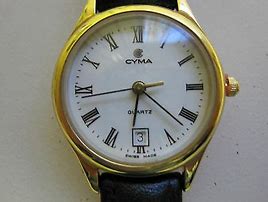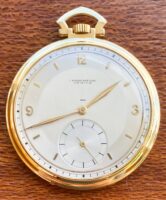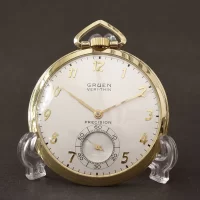








1862-1902
Fusing timeless elegance with contemporary flair, Cyma timepieces are the descendants of a long tradition of watchmaking that stretches back one-and-a-half centuries. The name Cyma has its roots in the French word “cime”, meaning “summit”, which, in turn, is derived from the Latin word “cyma”, meaning “a shoot”. It is a name that reflects not only the company’s constant striving for perfection but also the inextricable link with its birthplace in the Jura Mountains of Switzerland.
Initially, it was the harshness of the climate in the high valleys of the Jura – buried for more than half the year beneath deep snow and frequently cut off from the outside world – that gave rise to watchmaking activity during the long winters of isolation. During the 18th century, the efforts of the region’s industrious and ingenious inhabitants gradually led to the establishment of fully-fledged workshops for the design and manufacture of watches, and by 1780 watchmaking had developed into a process involving 30 distinct operations.
Inheritors of the horological gene that pervades the Jura, the two brothers Joseph and Theodore Schwob decided in 1862 to set up their own watchmaking company, Cyma, focusing much of their attention on avant-garde mechanical production techniques. Indeed, with its ongoing achievements in technical innovation, Cyma was one of the companies that made Neuchâtel the renowned centre of the watchmaking industry it is today.
Some 30 years later, the brothers went into partnership with a businessman called Frederic Henri Sandoz who had created a new watch company in Le Locle, another cradle of fine Swiss watchmaking. By this time, Cyma had established itself as a pioneer in the manufacture of intricate repeater watches, high complications and chronographs. The daily production was 150 pieces.
1903-1929
From the early 20th century onwards, the company received numerous awards, notably for its prowess in extra-slim watches. In 1903, it was awarded the coveted chronometer certificate issued by the Neuchâtel Observatory for its invention of a new extra-flat lever movement fitted inside a pocket watch. Two years later, Cyma introduced the calibre 701 with a thickness of just 3.85mm – a remarkable achievement for the time. In recognition of its watchmaking feats, the company won first prize at the World Fair in Brussels in 1910.
Output, meanwhile, had risen significantly, with some 2,500 movements being assembled daily in the workshops. From 1915, Cyma’s highly skilled designers and technicians were elaborating shock-resistant movements of unparalleled strength, along with the first waterproof models, which were finished to an equally high standard.
During the 1920s, the company was at the forefront of component interchangeability, which enabled its workshops to produce watches on a much bigger scale. By 1929, Cyma boasted the biggest workshop in Europe and employed 2,000 people to assemble 4,000 watches a day. In the same year, the company received first prize at the International Barcelona Exposition.
1930-1959
While men’s watches still accounted for the lion’s share of the business, in 1930 Cyma made an early foray into the ladies’ market with the Captive. It quickly became known for its elegance and precision, and was adopted by the legendary French writer, Collette, who was then at the height of her fame. She described the watch in her characteristic style: “It is a captive in the most romantic sense of the word… it is bought and sold. Sensitive and compliant, it yields if you handle it masterfully, revealing its face, divulging all its secrets, and each surrender simply adds to its charms…”
In 1943, Cyma unveiled its first automatic wristwatch, endowed with a 420 calibre featuring a unidirectional rotor. This presaged the ‘Autorotor’ 485 calibre of 1957.
The brand’s reputation was further enhanced with innovative products such as an eight-day mechanical alarm clock with single winding key (1945), the Sonomatic alarm clock (1957), and the gold Time-O-Vox alarm clock watch, which received official chronometer certification in 1956. The latter was the only one with the pleasant timbre of that period to ally a 464 calibre,12 1/2 inch, with a single barrel and small second.
1960-1988
The 1960s saw the launch of the Cyma-Navystar collection, showcasing an ultra-flat case that combined precision and perfect water resistance with refined elegance. More than 20 international patents protected the technological innovations conceived specifically to allow these timepieces to resist shocks such as immersion, under particularly demanding circumstances.
In 1980, breaking with the past, an extra-flat steel watch from Cyma’s modern era, endowed with a manufactured 6 x 7 3/4 calibre, scooped the Bijorhca gold award in Paris.
With the arrival of electronic watches, Cyma demonstrated its ability to adapt to technological evolution by launching the 1.2mm-thick, extra-slim Calibre 131 in 1984. To date, more than a million units have been produced and Cyma is an acknowledged specialist in thin quartz movements.
1989-2006
It was in 1989 that Cyma created its legendary Signature collection of timeless quartz watches, transcending trends with pure lines and seasonal variations. This was followed in 1992 by the elegant Charisma line of classic watches. At the end of the 1990s, the Imperium sport-chic collection of timepieces emerged, featuring a unique case design with screws on the side.
Moving into the new millennium has provided Cyma with the opportunity to revisit the most popular collections in its history. In 2000, the brand relaunched the Navystar, its flagship innovation of the 1960s. In 2004, the new Nineteen Forty collection was inspired by illustrious models of the 1940s, marrying classical style with perfect precision, in quartz, automatic or certified chronometer versions
2007-2011
Cyma’s commitment to innovative high-performance timepieces stands the test of time. Since 2007, Cyma has launched a series of new timepieces including the Grand Maestro, Grand Imperiu, Grand Skeleton and Europa. Embracing contemporary yet classic styles, and featuring sophisticated complications, these new models are authentic work of art perfectly enshrining Cyma’s continuing dedication to watchmaking craftsmanship and Swiss technology.
2012
To celebrate its 150th anniversary, the company has invested its horological savoir faire into a series of limited-edition timepieces. The Grand Imperiu Big Date Chronometer demonstrates its prowess in complicated watches, while an 18k solid-gold watch upholds the brand’s tradition of crafting classically beautiful watches, and a new ultra-slim model reinforces its long-established expertise in this domain.
Now based in Geneva, Cyma continues to adhere to the quality standards that were established 150 years ago, remaining true to the spirit of watchmaking perfected over time.
2013-2014
In 2013, Cyma welcomed an exciting brand ambassador in the shape of award-winning actor Liu Ye, who will help to further raise the brand’s profile in mainland China.
Having been the youngest ever winner of the Best Actor award at the Taipei Golden Horse Film Festival and Awards, however, he still experienced five anxious years out of the limelight. Today, Liu has moved on from the initial euphoria of flowers and applause, as well as the rumours and scandals that come as part and parcel of fame. He has achieved a balance between calm and passion, and his transition to the role of fatherhood provides him with a grounding in reality as his career scale new heights of success. For this reason, he is the perfect embodiment of Cyma’s brand slogan, ‘In time you’ll know’.
In 2014, Cyma welcomed Spanish football star Xavi Hernandez as its new brand ambassador. He is the first captain of one of the world’s top clubs, FC Barcelona. He demonstrated exceptional sporting talent throughout his footballing career and he has contributed to an impressive record of winning seasons, including the World Cup for 1 year, UEFA European Football Championship for 2 years, UEFA Champions League for 3 years, La Liga for 7 years, and FIFA Club World Cup for 2 years.
Control comes with time, Xavi’s legendary precision, mobility and pace-setting ability have carved out his position as the world’s greatest central midfielders and finest passers of the ball. He is the perfect embodiment of Cyma’s new advertisements featuring this footballing legend – Precision is the key to mastering your own time.
https://www.cyma.ch/brand/history/1862-1902
Please remember that this is an unofficial account of the history of this company, Should you happen to find any mistakes with our information then please let us know at



